Particle-turbulence interaction in vertical channel flow
- contact:
Markus Uhlmann, Aman G. Kidanemariam, Manuel Garcia-Villalba (UC3M Madrid)
- project group:
TS
- enddate:
2013
Fluid flow with suspended solid particles is encountered in a multitude of natural and industrial processes. Examples include the motion of sediment particles in rivers, fluidized beds and blood flow. Despite the great technological importance of these systems our understanding of the dynamics of fluid-particle interaction is still incomplete at the present date. Recently, however, significant progress has been made based on data provided by new experimental methods as well as numerical simulations. While most past investigations of numerical type have been performed in the context of the point-particle approach, it has now become possible to simulate the motion of a considerable number of finite-size particles including an accurate description of the surrounding flow field on the particle scale. Although the complexity of recent particle-resolved simulations (in terms of Reynolds number, number of particles and computational domain size) is still limited, new insight into the physics of fluid-particle systems is beginning to emerge from such studies.
 Here we are simulating turbulent flow in a vertically-oriented plane channel seeded with heavy spherical particles with a diameter corresponding to approximately 11 viscous (near-wall) turbulent length scales at a solid volume fraction of 0.4%. The pressure-driven upward flow (at constant flow rate) is found to be strongly modified due to the particle presence, with increased wall-shear stress and strongly enhanced turbulence intensity. The average relative flow, corresponding to a Reynolds number (based on particle diameter) of approximately 135, leads to the establishment of wakes behind individual particles.
Here we are simulating turbulent flow in a vertically-oriented plane channel seeded with heavy spherical particles with a diameter corresponding to approximately 11 viscous (near-wall) turbulent length scales at a solid volume fraction of 0.4%. The pressure-driven upward flow (at constant flow rate) is found to be strongly modified due to the particle presence, with increased wall-shear stress and strongly enhanced turbulence intensity. The average relative flow, corresponding to a Reynolds number (based on particle diameter) of approximately 135, leads to the establishment of wakes behind individual particles.
The accumulated data-base has been analyzed w.r.t. a number of derived statistical quantities. Some of these are: Voronoi analysis of the spatial structure of the dispersed phase; the statistics of particle acceleration; particle-conditioned averaging of the fluid flow field. We expect the data to be of further value for modeling purposes in the future. Please check here for simulation data.
[1] M. Uhlmann. Interface-resolved direct numerical simulation of vertical particulate channel flow in the turbulent regime. Phys. Fluids, 20(5):053305, 2008. DOI
[2] M. Garcia-Villalba, A.G. Kidanemariam, M. Uhlmann. DNS of vertical plane channel flow with finite-size particles: Voronoi analysis, acceleration statistics and particle-conditioned averaging. Int. J. Multiphase Flow, 46:54-74, 2012. DOI
